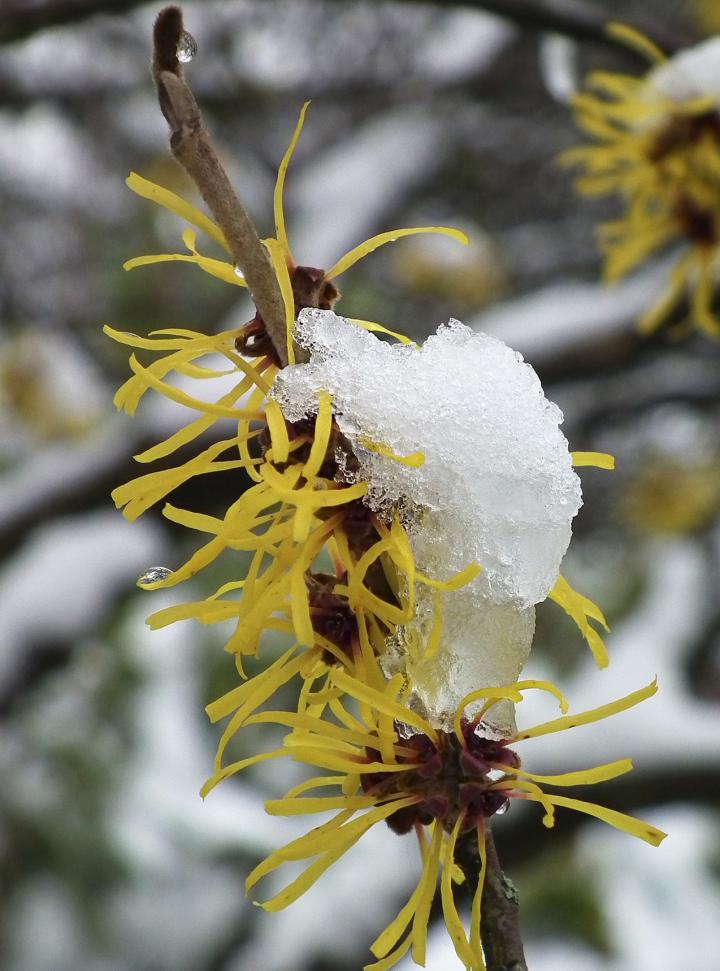Witch hazel (Hamamelis virginiana) is a humble but amazing native North American shrub. For centuries, this plant has been used to calm skin irritations and heal. You can even make your own tincture! Learn more.
Witch hazel is rare among flowering plants in that its delicate, spidery blossoms open in late fall, alongside last year’s fruits, and after its leaves have fallen.
A History of Healing
The bark, twigs, leaves and roots of witch hazel have been used for hundreds of years by native Americans to treat a host of ills. Native Americans used its flexible branches for making bows and harvested its seeds for food.
It’s one of only a handful of botanicals approved by the FDA as a drug, and its distilled extracts can still be found on most pharmacy shelves. Witch hazel’s calming components reduce swelling, help repair broken skin, and fight bacteria.
Specifically:
- Its extracts are used in many cosmetics and skin-care products, including aftershaves.
- Witch hazel soothes the pain and itch of bites, stings, sunburns, bruises and abrasions. Just soak a cotton pad in witch hazel and apply to the bite or burn
- Generations of new moms have used gauze pads soaked in witch-hazel to ease the pain of episiotomy or perineal tears after childbirth.
- It helps shrink hemorrhoids.
- It helps reduce undereye puffiness due to soothing fluid retention beneath the eyes.
- It is under active investigation for treating diabetes, skin cancers, chronic-wound care, and many other disease conditions.
Witch Hazel for Household First Aid
You can find many witch-hazel-containing products on drugstore or health-food-store shelves. Most of them are distilled products that usually contain about 14 percent of either ethyl or isopropyl alcohol as a preservative. Generations of Americans have used ordinary drugstore witch hazel as a mild antiseptic and astringent, an aftershave, a toner for oily skin and more.
Many people have trouble getting used to witch hazel’s odd smell, but it dissipates quickly after use. Lots of health-food store products containing witch hazel extracts mask the smell by adding essential oils of rose, lavender, or other aromatic herbs.

How to Make a Witch Hazel Tincture
A “tincture” is a nondistilled witch hazel which captures MORE of the plant’s natural astrigent compounds (called tannins), most of which don’t survive the distillation process.
With a tincture, you essentially just soaking the bark or herbs straight from the plant in alcohol or vinegar for weeks to extract the active constituents.
You can make these yourself if you have access to witch hazel trees in neighboring woods. (Use the native species, Hamamelis virginiana, rather than the ornamental varieties sold in plant nurseries.) Here’s how:
- To start, prune a few handfuls of twigs and small branches (please prune with care so you don’t injure the tree). To prune, ue a set of good scissor-type pruning shears. Locate the collar, the rough, swollen area at the base of each branch you plan to cut. Then locate the branch bark ridge (dark, raised area of compressed bark). Make your cut just outside the bark ridge and collar. This will allow the tree to heal its wound and prevent decay from spreading into the trunk.
- After using a sharp tool to peel and scrape as much of the bark as possible into your container, cut the twigs into small pieces. The bark, especially the inner bark, contains the highest concentration of healing compounds.
- Now you can either make a water-based witch hazel extraction or a long-lasting alchohol=based tincture.
Water-Based Witch Hazel Extraction or “Decoction”
Place the chopped twigs and scraped bark into a stainless-steel pot. Completely cover the witch hazel with water (use distilled water if your tap water is heavily treated). Bring the contents to a boil. Then cover the pot, and reduce heat and simmer for at least half an hour. Keep the twigs covered with water. Set in a cool place overnight, then strain into glass jar. Refrigerate and use within a few days.
Long-Lasting Alcohol Tincture
Place chopped bark and twigs in a large glass jar and cover with vodka. Let it sit in a dark, cool place for six weeks, then strain and store, covered, in a glass jar (also in a cool, dark place). To use, dilute a couple of tablespoons in half a cup of water. Soak clean gauze, washcloth, or cotton balls in the mixture, and apply.
Use the decoction or the dilute tincture on hemorrhoids, poison ivy, sunburns, bites and swellings, to soothe varicose veins, and tired muscles. You can also put some of the decoction or the diluted tincture into a spray bottle to spritz onto wounds, bruises, and itchy areas.
Although you may see references to sipping witch hazel teas and tonics for diarrhea and other conditions, most herbalists recommend using it internally only under the care of your healthcare professional.










